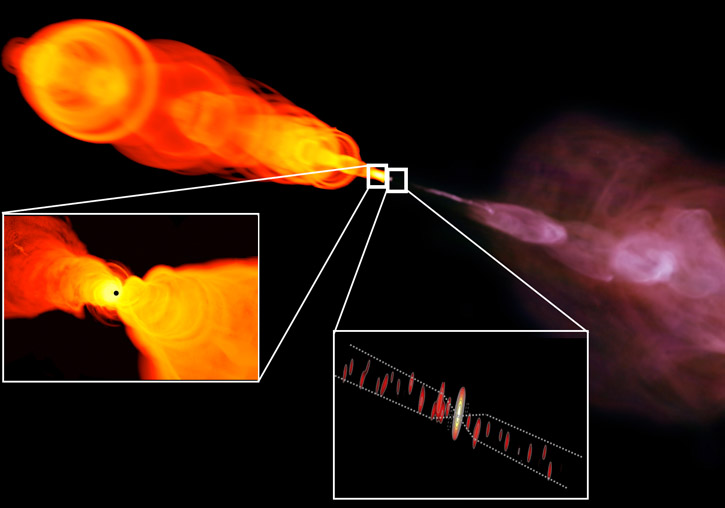
Manel Perucho, professor at the Department of Astronomy and Astrophysics of the University of Valencia, will investigate relativistic jets, superenergy rays that shoot out from the surroundings of black holes, in a project endowed with 3.6 million euros by the German Science Foundation. The study will analyse the conditions and mechanisms that allow these rays to be ejected, or how they influence the evolution of their environment, while allowing the training of young research personnel.
At the core of almost all the galaxies studied so far there are black holes. They have unimaginably large masses and therefore attract matter, gas, and even light. In fact, recently, astronomical images from the Event Horizon Telescope showing the accumulation of matter around a supermassive black hole have attracted a lot of public attention. These black holes also release enormous amounts of energy, originally stored in their rotation or in the potential energy of falling matter, into their surroundings. The energy release takes place in the form of jets.
The jets are collimated rays of plasma (particles and magnetic fields) along which particles are accelerated to enormous energies and are ejected from the centre of the galaxy at speeds very close to that of light. These jets can reach distances of hundreds of thousands of light years in space and emit across the entire electromagnetic spectrum, mainly radio, X-rays and gamma rays.
“The jets raise many questions relevant to the study of our Universe”, says Professor Manel Perucho in the Department of Astronomy and Astrophysics. “What are the conditions that allow them to be ejected, what mechanisms are responsible for the emission at high energies, or what is the way in which they influence the evolution of their progenitor galaxy and its environment?”, asks the expert.
These and other questions are precisely those that the new research group Relativistic Jets in Active Galaxies will try to solve, through theoretical development, numerical simulations, observations and interpretation of these observations.
The UV researcher adds: “a large part of the funding that has been requested will be dedicated to the training of young researchers, in the form of contracts to do doctoral theses and also to facilitate the holding of courses that allow us to transmit our knowledge in the field to them, and this fact also represents an opportunity for our students who are interested”.
The group consists of different nodes in Germany (Würzburg, Bonn, Hamburg, Heidelberg, Erlangen-Nuremberg and Potsdam), involves several universities and Max-Planck research institutes, and also incorporates two external members, or Mercator fellows: Professor Paola Grandi, from the University of Bologna (Italy), and Professor Manel Perucho, from the University of Valencia.
The German Science Foundation will fund the project with 3.6 million euros for the next 4 years (with the possibility of continuing in a second phase of financing for four more years). The group coordinator is Professor of Astrophysics Matthias Kadler, from the Julius-Maximilians University (JMU) in Würzburg (Bavaria).
According to Perucho, “the idea of the project is to coordinate efforts and approaches to the problem from theoretical and observational perspectives; for me it is a great illusion, because trying to achieve this fusion is what I have been doing in a personal capacity since I got my doctorate”. He adds that “even so, the project goes further, because it also incorporates observational studies at high energies, so the group will have great research potential, due to this innovative combination, and thanks to the latest advances in observational fields and numerical codes that allow us to make simulations of this scenario. I think it is very important, given the relevance that the jets are reaching both in Astrophysics and Cosmology, as well as in particle physic”.
Photo caption:
Holistic approach of the new group: observations (right) and observational modelling (left) of combined jets on the smallest and largest scales. (Collage: Matthias Kadler (JMU); based on images by C. Fromm (JMU), A. Baczko (MPIfR), R. Perley, and W. Cotton (NRAO / AUI / NSF).











